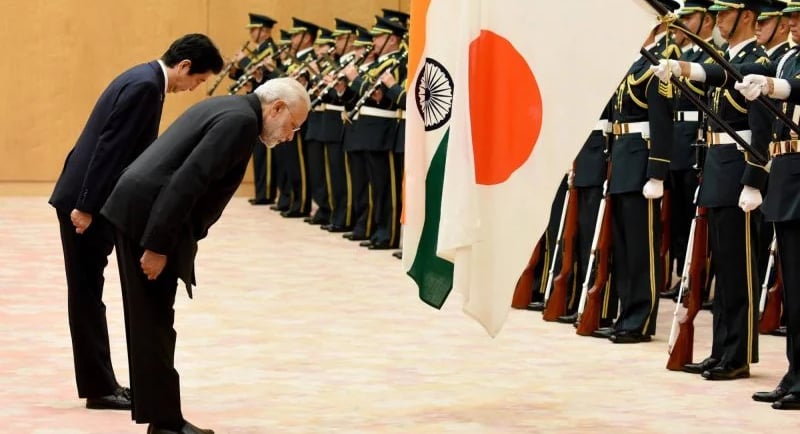The India-Japan Relationship: A Deep Dive into Centuries of Strategic & Spiritual Partnership
The bond between India and Japan is a unique tapestry woven over 1,500 years, blending spiritual exchange, wartime solidarity, and modern strategic partnership. This definitive guide explores the profound historical connections—from Buddhist monks to postwar diplomacy—and analyzes how this deep-rooted friendship evolved into a "Special Strategic and Global Partnership" crucial for the 21st-century Indo-Pacific.
SOCIAL


In an era of shifting global alliances, the partnership between India and Japan stands out as remarkably stable, deeply spiritual, and strategically vital. More than just diplomatic allies, these two Asian powerhouses share a friendship forged over millennia, rooted in cultural exchange and cemented by mutual respect during pivotal moments in history. This relationship, which has evolved from ancient religious ties to a modern framework covering defense, technology, and infrastructure, offers a masterclass in how shared values can create a enduring international partnership.
This article provides a comprehensive exploration of the India-Japan relationship, tracing its journey from the quiet footsteps of Buddhist monks to the high-level diplomatic agreements that shape the Indo-Pacific today.
Part 1: Ancient Foundations: The Spiritual Bridge (6th Century Onwards)
The earliest and most profound connection between India and Japan was not forged by diplomats or traders, but by spiritual seekers and the transformative philosophy of Buddhism.
The Journey of Buddhism: From India to Japan
In the 6th century CE, Buddhism began its journey from the Indian subcontinent, through China and the Korean Peninsula, before finally reaching the shores of Japan. This was not merely a transfer of religion; it was a comprehensive transmission of Indian culture, art, aesthetics, philosophy, and language.
Sanskrit's Linguistic Imprint: The Siddhaṃ script (Śiddhaṃātṛkā in Sanskrit), used for writing Buddhist scriptures, became a foundational element of Japanese religious and linguistic culture. Many Japanese Buddhist terms are direct loanwords from Sanskrit, creating an eternal, linguistic bond.
Architectural and Artistic Influence: The design of ancient Japanese temples, pagodas, and sculptures reflects the strong influence of Indian Buddhist art and Gupta period architecture. The serene expressions of Buddha statues in Nara and Kyoto find their artistic origins in the Gandhara and Mathura schools of art in ancient India.
The Symbolic Figure: Bodhisena and the Great Buddha of Nara
A pivotal moment that underscores this early connection occurred in 752 AD. The Indian Buddhist monk Bodhisena, known in Japan as the "Baramon Sōjō" (Brahmin Bishop), was invited to perform the eye-opening ceremony for the consecration of the colossal bronze statue of Vairocana Buddha—the Daibutsu—at Todaiji Temple in Nara.
This event was of immense national significance for Japan, presided over by Emperor Shōmu. That an Indian monk was chosen for this supreme honor is a powerful testament to the reverence Japan held for India as the birthplace of Buddhism. Bodhisena’s presence symbolizes the deep spiritual debt Japan acknowledged to Indian culture.
Part 2: Rekindling Ties: The Intellectual Bridge (19th - Early 20th Century)
After centuries of limited contact, the late 19th and early 20th centuries saw a rekindling of ties, this time led by intellectuals and revolutionaries.
The Japan-India Association: Institutionalizing Friendship
The Japan-India Association, established in 1903, is Japan's oldest international friendship body. Its founding reflected a growing Japanese interest in India's spiritual heritage and a recognition of the potential for broader Asian solidarity. This organization became a crucial platform for dialogue and exchange long before formal diplomatic relations were established.
Tagore and Okakura: A Meeting of Philosophical Minds
The meeting of minds between Indian Nobel laureate Rabindranath Tagore and Japanese art scholar Okakura Kakuzō was instrumental in rebuilding cultural bridges. Okakura’s famous opening line in his book The Ideals of the East (1903), "Asia is one," resonated deeply with Indian intellectuals. Tagore’s visits to Japan in 1916 and 1924 were celebrated events, where he spoke about the need for East-West harmony and the shared spiritual heritage of Asia. Though sometimes critical of Japan's growing nationalism, Tagore’s dialogues fostered a crucial intellectual connection.
Rash Behari Bose: A Revolutionary Bond
The story of Rash Behari Bose, a key figure in the Indian independence movement, is a thrilling chapter in India-Japan relations. Fleeing from British authorities, he found refuge in Japan in 1915. With the support of influential Japanese figures like Pan-Asianist Mitsuru Tōyama, Bose not only evaded capture but also married a Japanese woman and became a Japanese citizen. He played a critical role in mobil Japanese support for the Indian independence cause, creating a unique, solidarity-based link that transcended diplomacy.
Part 3: Postwar Solidarity: The Diplomatic Bridge (1947-1952)
India’s actions following World War II and its own independence were crucial in building a reservoir of goodwill in Japan that persists to this day.
A Swift Recognition and a Symbol of Hope
Japan was among the very first countries to recognize the newly independent India in 1947. But India's gestures in return were profoundly symbolic. In 1949, Prime Minister Jawaharlal Nehru sent Indian elephants to the war-ravaged Ueno Zoo in Tokyo. For a generation of Japanese children growing up in the bleakness of postwar recovery, these elephants, named "Indira" and "Nehru," became beloved symbols of hope and friendship.
The San Francisco Peace Conference: A Stand of Principle
In 1951, India took a principled and independent stand that Japan would never forget. India refused to attend the San Francisco Peace Conference, disagreeing with the terms imposed on Japan by the Allied powers. Instead, India chose to negotiate directly and respectfully with Japan as a sovereign equal.
This led to the signing of a separate bilateral peace treaty in June 1952—one of the first peace treaties Japan signed after the war. Furthermore, in an act of extraordinary magnanimity, India waived all reparation claims against Japan. This decision, driven by a understanding of Japan's plight, cemented a deep and lasting sense of gratitude and goodwill.
Part 4: Modern Partnership: The Strategic & Economic Bridge (1958 - Present)
The foundation of goodwill was strategically leveraged to build a robust economic and strategic partnership.
Iron Ore and Yen Loans: Fueling Postwar Growth
India’s export of iron ore was critical for Japan’s skyrocketing steel industry and its miraculous postwar economic recovery. Recognizing the potential for mutual growth, Japan began providing Yen Loans to India in 1958, making Japan India’s first and largest source of overseas development assistance (ODA). These loans funded critical infrastructure projects in power, transportation, and irrigation, laying the groundwork for India's own economic development.
The "Special Strategic and Global Partnership"
Today, the relationship is stronger than ever, encapsulated in the "Special Strategic and Global Partnership." Key pillars include:
Economic Cooperation: Japan is a key investor in Indian infrastructure, most notably the Mumbai-Ahmedabad High-Speed Rail (Bullet Train) project. Japanese companies are major investors in India's automotive, electronics, and digital sectors.
Defense and Security: With shared concerns over regional stability, India and Japan hold regular joint military exercises (like MALABAR with the USA), and have signed agreements for reciprocal access to each other's military facilities for supplies and services.
The Quad: Both nations are key members of the Quadrilateral Security Dialogue (Quad) alongside the United States and Australia, working towards a free, open, and inclusive Indo-Pacific.
